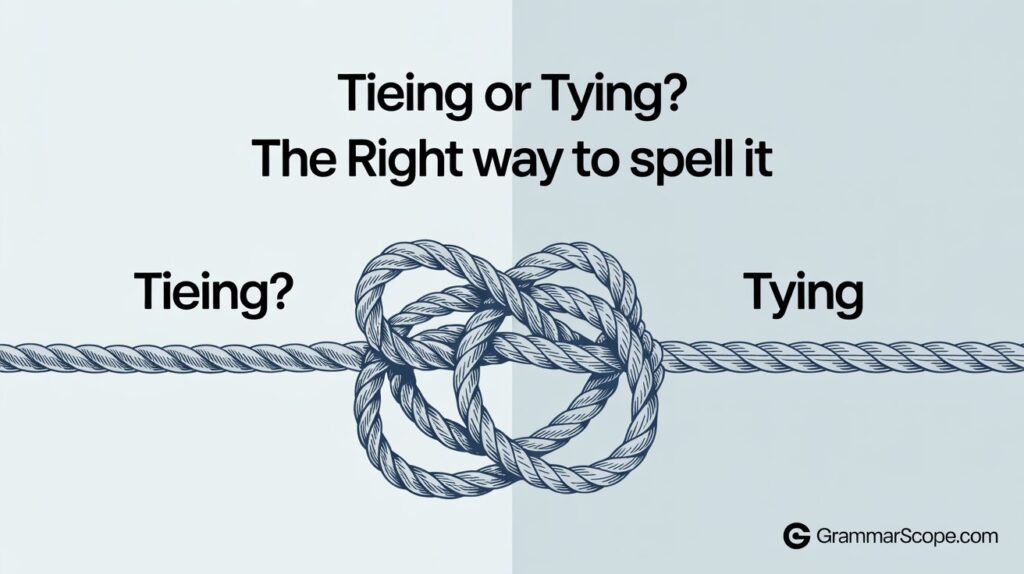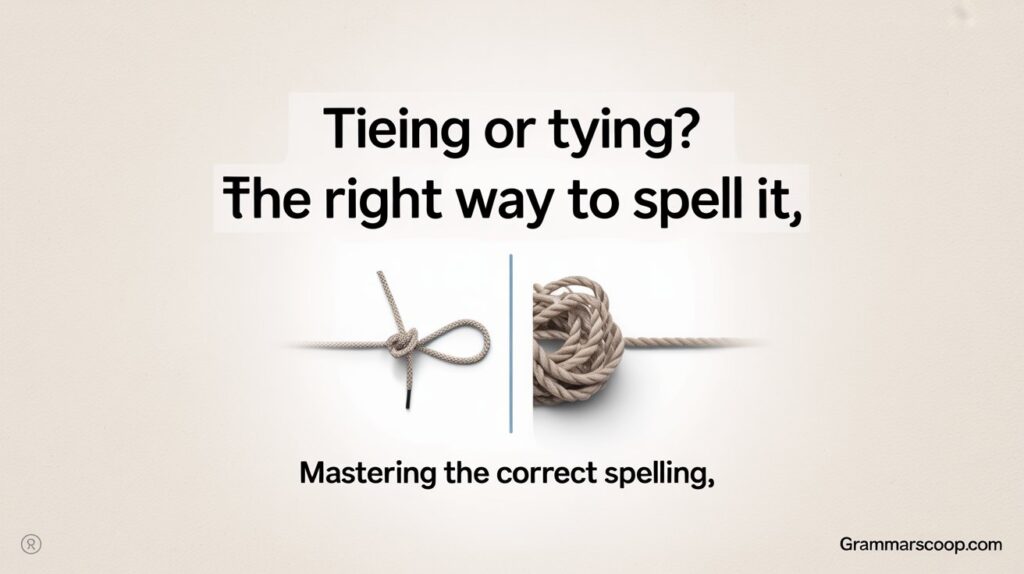If you’ve ever stopped mid sentence and thought, “Wait… is it Tieing or Tying?” you’re not alone. Spelling in English can be tricky, even for native speakers. The confusion between tying and tieing is one of those common spelling dilemmas that makes writers second-guess themselves.
This article clears up the confusion once and for all by explaining the correct spelling of tying, why “tieing” looks right but isn’t, and when and how to use “tying” correctly in everyday language.
Quick Answer: Is It Tieing or Tying?

The correct spelling is tying.
“Tieing” is not a standard English word and is considered incorrect in modern usage.
Tying is the present participle of the verb tie, meaning “to fasten or secure with a string, rope, or similar means.”
So the next time you’re tying your shoes, your score, or the knot—you’ll know you’re spelling it right.
Why the Confusion Happens
The confusion between “tying” or “tieing” is totally understandable. Here’s why:
1. The Word “Tie” Ends in “e”
In English, when forming the present participle of a verb that ends in -e, you often drop the “e” and add “-ing.” But some exceptions and irregular verbs throw people off.
For instance:
| Base Verb | Present Participle |
|---|---|
| bake | baking |
| move | moving |
| tie | tying |
But then, you get:
| Base Verb | Present Participle |
|---|---|
| dye | dyeing |
| lie | lying |
| die | dying |
It’s no wonder learners and even fluent speakers scratch their heads when spelling words like tying.
2. It Looks Like It Should Be “Tieing”

We naturally assume that keeping the root word intact is correct, especially because “tie” is so short. So “tieing” appears logical. But in English spelling, appearances are often deceiving.
Fact: “Tieing” was occasionally used in 19th-century texts but has since fallen out of standard usage. Today, spellcheck will flag it as incorrect.
Grammar Rule Behind “Tying”
Let’s break down the grammar rule for tying and why the spelling makes perfect sense once you understand it.
General Rule for Verbs Ending in “e”
When adding “-ing” to most verbs ending in -e, you drop the “e” and add “-ing.”
Examples:
- write → writing
- ride → riding
- bake → baking
- tie → tying
This is a common spelling rule in English.
But What About Verbs Ending in “-ie”?
Good question. Here’s the spelling rule for verbs ending in -ie:
When a verb ends in -ie, you change the -ie to -y and then add -ing.
| Verb | Present Participle | Rule Applied |
|---|---|---|
| die | dying | ie → y + ing |
| lie | lying | ie → y + ing |
| tie | tying | ie → y + ing |
This rule helps avoid awkward and incorrect spellings like dieing or tieing, which both look clunky and are grammatically incorrect.
Is “Tieing” Ever a Word?
Technically speaking, “tieing” is not a standard word in English.
But… Was It Ever Used?
Yes, “tieing” has appeared in historical texts, especially in the 1800s. Some nautical or industrial jargon used it, but that usage is obsolete.
Today, professional writing platforms, dictionaries, and grammar tools like Grammarly or Microsoft Word do not recognize “tieing” as valid.
Modern Verdict: If you’re wondering “is it tying or tieing” for a job application, academic paper, or blog—stick with tying.
Definitions and Use of “Tying”

READ MORE:
- Cancelation or Cancellation: Which Spelling is Correct?
- Requestor or Requester: Which Spelling to Use?
Tying Definition
According to Merriam-Webster, tying is defined as:
The act of fastening or binding something with a cord, rope, or similar material.
But the meaning of “tying” extends beyond ropes and shoelaces.
Common Contexts
- Literal use:
- She’s tying a bow on the gift.
- They were tying their laces before the game.
- Figurative use:
- He’s tying the score in the final seconds!
- She’s tying her career to that company.
Tying vs. Tieing Difference
| Term | Standard Usage | Dictionary Validity | Commonality |
|---|---|---|---|
| tying | Yes | Yes | High |
| tieing | No | No | Rare |
Examples of Tying in Sentences
Here are a few examples of tying in a sentence, showing how it adapts to different contexts:
- She’s tying her hair back before the run.
- We’re tying the boat to the dock.
- The match ended with both teams tying the score.
- He’s tying his success to that one decision.
- They kept tying the ribbons tighter and tighter.
Each example shows correct usage of tying in real-world settings.
Words That Follow the Same Spelling Pattern
Here’s a helpful table of verbs that behave like “tie” when forming their -ing form:
| Base Verb | -ing Form | Notes |
|---|---|---|
| tie | tying | Drop “e,” follow -ie rule |
| die | dying | Change -ie to -y |
| lie | lying | Change -ie to -y |
| vie | vying | Drop “e” and replace -ie with -y |
| cry | crying | Ends in “y,” just add -ing |
These help reinforce the tying spelling rule in English.
Synonyms for “Tying” and When to Use Them
Let’s explore some tying synonyms based on different contexts:
Physical Action Synonyms:
- Fastening
- Securing
- Binding
- Knotting
Figurative Synonyms:
- Linking
- Connecting
- Associating
- Joining
Use Case Examples:
- Fastening: “He was fastening the rope around the tree.”
- Connecting: “The project is connecting two separate departments.”
- Binding: “The agreement is legally binding both parties.”
Each word provides nuance, so choose your tying synonyms based on your context.
Etymology of “Tying”
Understanding the origin of a word can help you remember how it’s spelled.
- The verb “tie” comes from Old English tīegan, which means “to bind.”
- It has roots in Proto-Germanic teuhan and Old Norse tūgja, referring to draw or pull.
- Over centuries, the meaning evolved but always retained the core idea of binding or fastening.
This deep linguistic history explains why “tie” isn’t just about shoelaces. It’s about connection, control, and closure.
Common Misspellings and Mistakes
Misspelling “tying” is more common than you’d think.
Top Misspellings:
- tieing
- tyin
- tiying
Why They Happen:
- Misapplying standard English rules
- Confusing tie with die or lie
- Over-correction when trying to preserve the root word
Memory Tip: “To spell tying correctly, remember: drop the ‘e’ and don’t look back.”
Autocorrect Impact:
Modern autocorrect tools usually catch “tieing” and switch it to “tying.” Still, double-checking your work is always wise, especially in formal documents.
Final Thoughts: How to Remember “Tying”
Still asking, “How to spell tying correctly?” Here are final pointers to help lock it in:
Mnemonic:
TIE + ING – E = TYING
Quick Recap:
- “Tying” is the correct and only standard spelling
- “Tieing” is outdated and incorrect in modern English
- It follows the spelling rule for verbs ending in -ie
- It appears in both literal and figurative language
Visual Reminder:
_________
| |
| TYING | ← Correct
|_________|
| TIEING | ← Incorrect
|_________|
Frequently Asked Questions
What is the correct spelling of tying?
The correct spelling is tying. Always drop the “e” before adding “-ing.”
Why is tieing wrong?
It doesn’t follow the English grammar rule for verbs ending in “e” or “ie.” It’s not found in standard dictionaries.
Are there other examples like tying?
Yes, verbs like dying, lying, and vying follow similar rules and often confuse learners too.
Is tieing ever acceptable?
Not in modern usage. It may have occurred in older texts but is now considered incorrect.
Conclusion
Next time you’re typing or texting and wonder, “Is it tying or tieing?”—you’ll know the answer. The correct spelling is always tying. Let the rules, the history, and the examples guide you, and you’ll never second-guess yourself again.
Now that you’ve mastered this quirky quirk of English spelling, go forth and tie up your writing—cleanly and correctly.
Want to explore more tricky grammar issues like this? Stay tuned for upcoming posts on English spelling confusion, punctuation rules, and more!

Lisa Morris is a seasoned blogger and language enthusiast with a passion for making grammar simple and engaging. At Grammar Scoop, she shares clear, concise tips that help readers master the rules of English with confidence.






